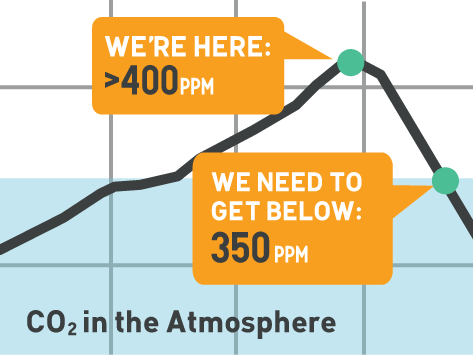 The origins of 350 and the history of atmospheric CO2
The origins of 350 and the history of atmospheric CO2
That “350 ppm” is where 350.org gets its name. “PPM” stands for “parts per million,” which is a way of measuring the ratio of carbon dioxide molecules to all of the other molecules in the atmosphere. Countless scientists, climate experts, and governments officials agree that 350 ppm is the “safe” level of carbon dioxide.
Since the beginning of human civilization, our atmosphere contained about 275 ppm of carbon dioxide. Renowned climatologist Dr. James Hansen wrote that these are the conditions “on which civilization developed and to which life on earth is adapted.” To go beyond this risks disrupting our global climate system’s 1,000,000+ years of relative stability. Beginning in the 18th century, humans began to burn coal, gas, and oil to produce energy and goods. The carbon in the atmosphere began to rise, at first slowly and now more quickly. Many of the activities we do every day like turning the lights on, cooking food, or heating our homes rely on energy sources that emit carbon dioxide and other greenhouse gases. We’re redistributing millions and millions of years worth of carbon, once stored beneath the earth as fossil fuels, and releasing it into the atmosphere.
Where are we now?
Right now we’re well over 400 ppm, and we’re adding over 2 ppm of carbon dioxide to the atmosphere every year. Unless we are able to rapidly turn that number around and acheive below 350 ppm this century, we risk triggering tipping points and irreversible impacts that could send climate change spinning truly beyond our control. So far, we’ve experienced about 1 degree (Celsius) of warming, and the impacts to the environment and society are frightening.

New Orleans, LA — Hurricane Katrina, August 30, 2005.
Photo by Jocelyn Augustino/FEMA
What does this mean?
Glaciers and ice sheets everywhere are melting and disappearing fast, causing sea level rise, threatening the primary source of clean water for millions of people and changing global hydrology patterns. Mosquitoes, who like a warmer world, are spreading into lots of new places, and bringing malaria and dengue fever with them. Extreme droughts and flooding are becoming much more common across the globe, making conditions unpredictable and food harder to grow. Sea levels have begun to rise, spurning expensive relocation efforts, often for vulnurable communities.
By the end of the century, many of the world’s cities, island nations, and farmlands will be underwater. Meanwhile, the oceans are growing more acidic because of the CO2 they are absorbing, which makes it harder for animals like corals and clams to build their shells and exoskeletons. All around the globe, we’re stacking the deck for extreme weather — like hurricanes, typhoons, blizzards, and droughts — which exacerbates conflicts and security issues in regions that are already strapped for resources.
The Arctic is sending us perhaps the clearest message that climate change is occurring much more rapidly than scientists had previously thought. In the summer of 2012, roughly half of the Arctic’s sea ice went missing (some scientists estimate that the total volume of summer sea ice loss may be as high as 80%). The entire Arctic region is undergoing drastic changes, threatening vital habitat for countless species (yes, including polar bears) and the livelihoods of many indigenous communities. This is also bringing us closer to dangerous tipping points, like the breakdown of the Greenland ice sheet and major methane releases from quickening permafrost melt.
As far back as 1896, founders of modern science connected industrial coal burning to high atmospheric carbon with global warming. Throughout following century, they have found —without a doubt — that rapid change is occurring on our planet. While much of the details are still being studied, one thing is no longer up for debate: our climate is changing profoundly and rapidly, and human activity is the cause.
That’s why MN350’s mission is to bring Minnesotans into the global 350.org movement, fighting climate change on a local level to create a just and healthy future for all.

